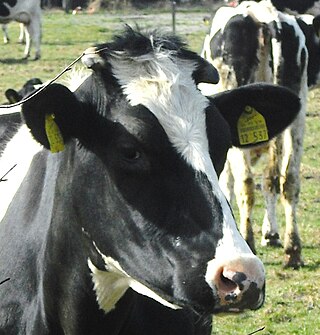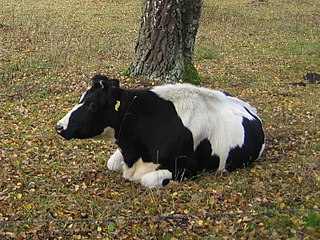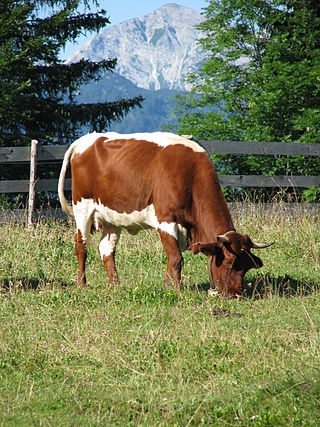
The Holstein Friesian is an international breed or group of breeds of dairy cattle. It originated in the Dutch provinces of North Holland and Friesland and in Schleswig-Holstein in northern Germany. It is the dominant breed in industrial dairy farming worldwide, and is found in more than 160 countries. It is known by many names, among them Holstein, Friesian and Black and White.

The Charolais or Charolaise is a French breed of taurine beef cattle. It originates in, and is named for, the Charolais area surrounding Charolles, in the Saône-et-Loire department, in the Bourgogne-Franche-Comté region of eastern France.

The Simmental or Swiss Fleckvieh is a Swiss breed of dual-purpose cattle. It is named after the Simmental – the valley of the Simme river – in the Bernese Oberland, in the canton of Bern in Switzerland. It is reddish in colour with white markings, and is raised for both milk and meat.

The Guernsey is a breed of dairy cattle from the island of Guernsey in the Channel Islands. It is fawn or red and white in colour, and is hardy and docile. Its milk is rich in flavour, high in fat and protein, and has a golden-yellow tinge due to its high β-carotene content. The Guernsey is one of three Channel Island cattle breeds; the other two are the Alderney, which is now extinct, and the Jersey.

Dairy cattle are cattle bred for the ability to produce large quantities of milk, from which dairy products are made. Dairy cattle generally are of the species Bos taurus.

The Dairy Shorthorn is a British breed of dairy cattle. It derives from the Shorthorn cattle of Tees-side, in the North Riding of Yorkshire and in Northumbria in north-eastern England. The Shorthorn was for this reason at first known as the Durham or Teeswater.

The Brown Swiss or American Brown Swiss is an American breed of dairy cattle. It derives from the traditional triple-purpose Braunvieh of the Alpine region of Europe, but has diverged substantially from it. It was selectively bred for dairy qualities only, and its draft and beef capabilities were lost. Milk yield was measured in 2013 at 10231 kg (22600 lb) per year; the milk has about 4% butterfat and 3.5% protein and is suitable for making cheese.

The Ayrshire is a Scottish breed of dairy cattle. It originates in, and is named for, the county of Ayrshire in south-western Scotland. Ayrshires typically have red and white markings; the red can range from a shade of orange to a dark brown.

The Belted Galloway is a traditional Scottish breed of beef cattle. It derives from the Galloway cattle of the Galloway region of south-western Scotland, and was established as a separate breed in 1921. It is adapted to living on the poor upland pastures and windswept moorlands of the region. The exact origin of the breed is unclear, although the white belt for which they are named, and which distinguishes the breed from black Galloway cattle, is often surmised to be the result of cross-breeding with the similarly-coloured Dutch Lakenvelder breed.

The Braunvieh or Swiss Brown is a breed or group of breeds of domestic cattle originating in Switzerland and distributed throughout the Alpine region. It falls within the "Brown Mountain" group of cattle breeds. The Swiss Braunvieh was originally a triple-purpose animal, used for milk production, for meat and for draught work; the modern Braunvieh is predominantly a dairy breed.

Beef cattle are cattle raised for meat production. The meat of mature or almost mature cattle is mostly known as beef. In beef production there are three main stages: cow-calf operations, backgrounding, and feedlot operations. The production cycle of the animals starts at cow-calf operations; this operation is designed specifically to breed cows for their offspring. From here the calves are backgrounded for a feedlot. Animals grown specifically for the feedlot are known as feeder cattle, the goal of these animals is fattening. Animals not grown for a feedlot are typically female and are commonly known as replacement heifers. While the principal use of beef cattle is meat production, other uses include leather, and beef by-products used in candy, shampoo, cosmetics, and insulin.

The Shetland, known natively in the Scots language as Shetland kye is a small, hardy Scottish breed of cattle from the Shetland Islands to the north of mainland Scotland. The cattle are normally black and white in colour but there are smaller numbers in grey, red and dun.

German Black Pied cattle are a breed of dairy cattle that originated in the North Sea coast regions of northern Germany and the Netherlands.
Jamaica Hope is a dairy breed of cattle originating from Hope Farm in Jamaica.
The Tipo Carora or Carora is a Venezuelan breed of dairy cattle. It was bred in the early part of the twentieth century by crossing of local Criollo cows with imported Brown Swiss bulls. It is named for its place of origin, the town of Carora in the Venezuelan state of Lara.

The Fjäll is a traditional Swedish breed of polled mountain cattle. It was threatened with extinction in the 1970s and 1980s, but recovered after a breed association was formed in 1995, partly thanks to stocks of frozen semen. Microsatellite analysis has shown it to be closely related to the endangered Bohuskulla breed.

The Swedish Friesian, Swedish: 'Svensk Låglandsboskap', often abbreviated to SLB, is a Swedish breed of dairy cattle. It was established in about 1870 from imports of cattle of Dutch Friesian or German Black Pied type. From about 1970 it has been systematically cross-bred with the American Holstein-Friesian breed, to the point that the original Swedish type may be extinct. The name Swedish Holstein may also be used.It is a type of Swedish cattle breed.

The Valdostana Castana is an Italian breed of cattle from Valle d'Aosta region in north-western Italy. It is one of three regional breeds in the area, the others being the Valdostana Pezzata Nera and the Valdostana Pezzata Rossa. The Valdostana Castana ranges in colour from chestnut-brown to black. It derives from cross-breeding of imported Hérens stock with the local Pezzata Nera (black-pied) cattle. While the Valdostana Castana is raised both for meat and for milk, its principal characteristic is its ability in the Bataille de Reines, the annual cow-fighting contests held in the region. Partly due to its combative nature, it is not suited to intensive farming, and management is normally transhumant: the cattle are stabled only in winter, and spend the summer months on the mountain pastures of the Alps.
The Swiss Holstein is the Swiss variant of the international Holstein-Friesian breed of dairy cattle. It results from systematic cross-breeding, through artificial insemination between 1966 and 1973, of the traditional dual-purpose black-pied Fribourgeoise from the Canton of Fribourg in western Switzerland with Canadian Holstein stock.

Cika cattle is an autochthonous breed of cattle, originating in Slovenia. This red to chestnut brown cow is used to grazing on alpine pastures and was traditionally raised to serve as a dairy cow – giving people milk and taking care of calves. The Slovenian Cika is the only Slovenian autochthonous breed of cattle.

















